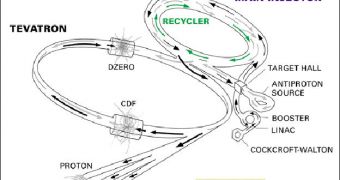More than three decades ago, experts showed in a series of calculations that it's theoretically possible for particle accelerators to produce a lot more energy from their experiments than they consume running them. The idea was again brought to life recently, as experts investigated an old idea. The concept proposed that actually obtaining energy from particle accelerators is entirely possible. The theory was created by accelerator physicist Robert Wilson, who played a critical part in the creation of the now-famous Fermi National Accelerator Laboratory (Fermilab), in Batavia, Illinois.
Back in 1976, when the accelerator called the Energy Doubler/Saver was being constructed, the expert came up with a set of calculations to show how proton beams could be directly responsible for the creation of vast amounts of energy derived from nuclear fission. The Energy Doubler was the first machine to employ large-scale superconducting magnets, which raised an interesting prospect of how much power would be used. Back in the day, Wilson was director of Fermilab, and the scientist in charge of the Energy Doubler construction effort.
“One consequence of the application of superconductivity to accelerator construction is that the power consumption of accelerators will become much smaller,” he said in the 1976 paper. He proposed that protons in this accelerator could be sent into a block of uranium. This would produce a particle shower featuring no less than 60,000 neutrons, which would then go on to be absorbed by nuclei. The end result would be 60,000 plutonium atoms, which could release as much as 0.2 GeV (gigaelectronvolts) of energy when burned in a fission reactor, Technology Review reports.
Wilson showed that 60,000 such atoms (or a single 1,000 GeV proton) would therefore produce up to 12,000 GeV of nuclear fission energy. Granted, the actual process would have massive losses, but the large conversion rate certainly makes the idea worth investigating. “There are probably better ways of producing plutonium, but it does appear that it would be feasible to construct an intense proton accelerator that would produce more energy than it consumes,” the expert added in his proposal.

 14 DAY TRIAL //
14 DAY TRIAL //